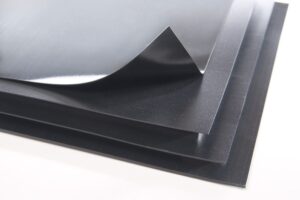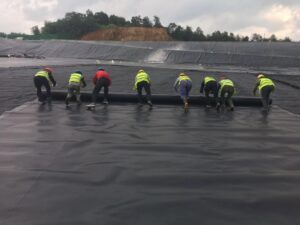What is the tensile strength of geomembrane properties?
Performance of geomembrane Tensile strength refers to the maximum tensile force that the geomembrane can withstand under the action of tension. This is determined by tensile testing, which typically applies a tensile force perpendicular to the plane of the geomembrane to simulate the tensile stresses that may occur in actual use.
Tensile strength is a measure of the tensile properties of a geomembrane material in a tensile state, usually expressed in units of unit area, such as megapascals (MPa).
The basic steps of tensile testing include:
Sample preparation: Obtain samples from the actual geomembrane used to ensure that the samples are representative. The sample preparation process needs to follow relevant standards or procedures.
Equipment Setup: Use a professional tensile testing machine for testing. The machine should be able to apply uniform tensile force in the vertical direction and record relevant deformation and load data.
Clamping: Clamp both ends of the geomembrane on the testing machine, making sure the clamping is even to avoid introducing unnecessary stress concentrations at the clamping points.
Stress and strain measurement: During the test, the deformation and stress of the geomembrane need to be measured. This can be achieved by installing appropriate strain gauges and load cells on the testing machine.
Apply load: Start applying tension so that the geomembrane gradually stretches. During the stretching process, the strain of the geomembrane and the applied load were recorded.
End point definition: Tensile testing usually ends when the geomembrane ruptures or reaches a predetermined tensile limit. The tester records and reports this.
Data Analysis: Use the recorded data to calculate tensile strength, which is typically the maximum stress that occurs during stretching of a material.

Why measure geomembrane performance tensile strength?
Tensile strength is a key parameter for geomembrane performance and is crucial for many engineering applications, such as anti-seepage, groundwater control, etc.
When selecting a geomembrane, design engineers usually consider the tensile strength of the geomembrane to ensure that it can withstand the corresponding tensile stress in the actual application.
Measuring the tensile strength of geomembrane properties is very important as it provides critical information about the tensile performance of the geomembrane under tensile stress. The following are important reasons for measuring tensile strength of geomembrane properties:
Engineering Design and Safety: In many engineering applications, geomembranes are used for waterproofing, anti-seepage, isolation and other purposes. Tensile strength is a key parameter and engineers need to ensure that the geomembrane can withstand the stresses associated with tension in actual use to ensure the safety and stability of the structure.
Coping with external forces: In actual use, geomembranes may be affected by various external forces, such as groundwater pressure, soil deformation, etc. Measurement of tensile strength can help determine how a geomembrane will perform under these external forces, allowing selection of the appropriate geomembrane type and thickness.
Material Selection: Different types of geomembranes may have different tensile strengths. By measuring tensile strength, engineers can help engineers select geomembrane materials suitable for specific project requirements.
Engineering Quality Control: In civil engineering, quality control is crucial. By measuring the tensile strength of geomembranes, quality control can be performed on the production and construction process to ensure that the geomembranes used meet design specifications and requirements.
Durability Assessment: Geomembranes are often required to maintain their performance over a long period of time. Measurement of tensile strength can provide information about the durability and long-term stability of a geomembrane, helping to evaluate its performance over its service life.
Overall, measuring the tensile strength of geomembrane properties is an important step in engineering design, quality control, and safety assessment to ensure that the geomembrane will meet its design and functional requirements in practical applications.

Test Method for Determining Geomembrane Properties Tensile Strength Using Broadband Testing
Determining the tensile strength of geomembrane properties is accomplished through broadband testing, typically using tensile testing. Tensile testing can provide the performance parameters of geomembranes under stress, one of the most important is tensile strength. The following is the general testing method:
Sample preparation: Take samples from actual geomembranes in use to ensure that the samples are representative. The sample preparation process needs to follow corresponding standards to ensure the accuracy and repeatability of the test.
Equipment Setup: Use a professional tensile testing machine for testing. The machine should be able to apply uniform tensile force in the vertical direction and record relevant deformation and load data.
Clamping: Clamp both ends of the geomembrane on the testing machine, making sure the clamping is even to avoid introducing unnecessary stress concentrations at the clamping points.
Stress and Strain Measurements: During testing, the geomembrane’s strains and stresses need to be measured. This can be achieved by installing appropriate strain gauges and load cells on the testing machine.
Apply load: Start applying tension so that the geomembrane gradually stretches. During the stretching process, the strain of the geomembrane and the applied load were recorded.
End point definition: Tensile testing usually ends when the geomembrane ruptures or reaches a predetermined tensile limit. The tester records and reports this.
Data Analysis: Use the recorded data to calculate tensile strength, which is typically the maximum stress that occurs during stretching of a material. Tensile strength is usually reported per unit area, such as MPa.
Standard compliance: Ensure that the testing process complies with applicable standards, such as ASTM’s relevant standards, to ensure testing accuracy and comparability.
When conducting geomembrane tensile strength testing, environmental factors such as test temperature and humidity also need to be considered to ensure the reliability of the test results.
The final test report should include test conditions, sample information, tensile strength and other performance parameters.
Author

Founded in 2002, Tinhy's team focuses on the manufacturing, marketing, installation, application and research and development of geosynthetic materials.
View all posts






